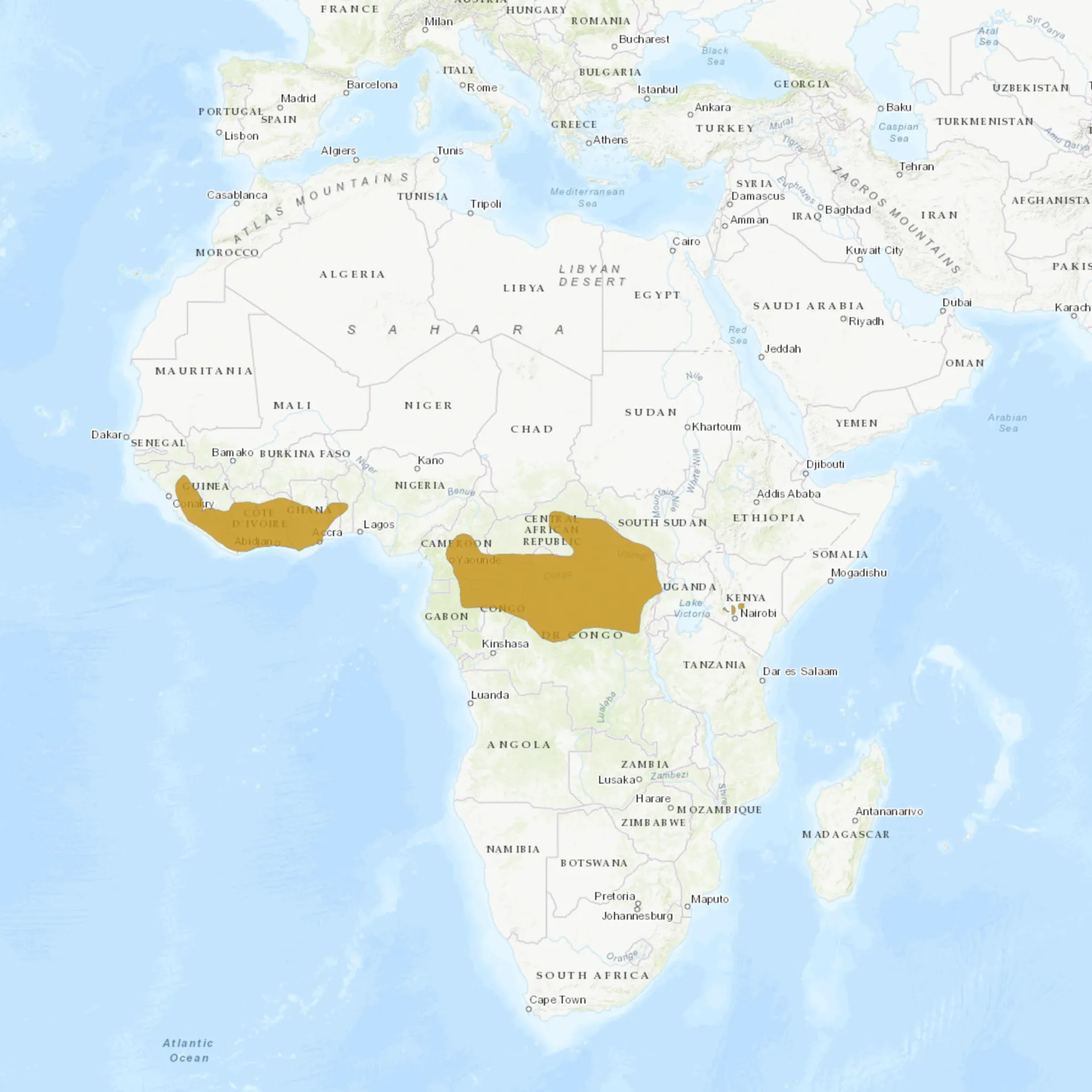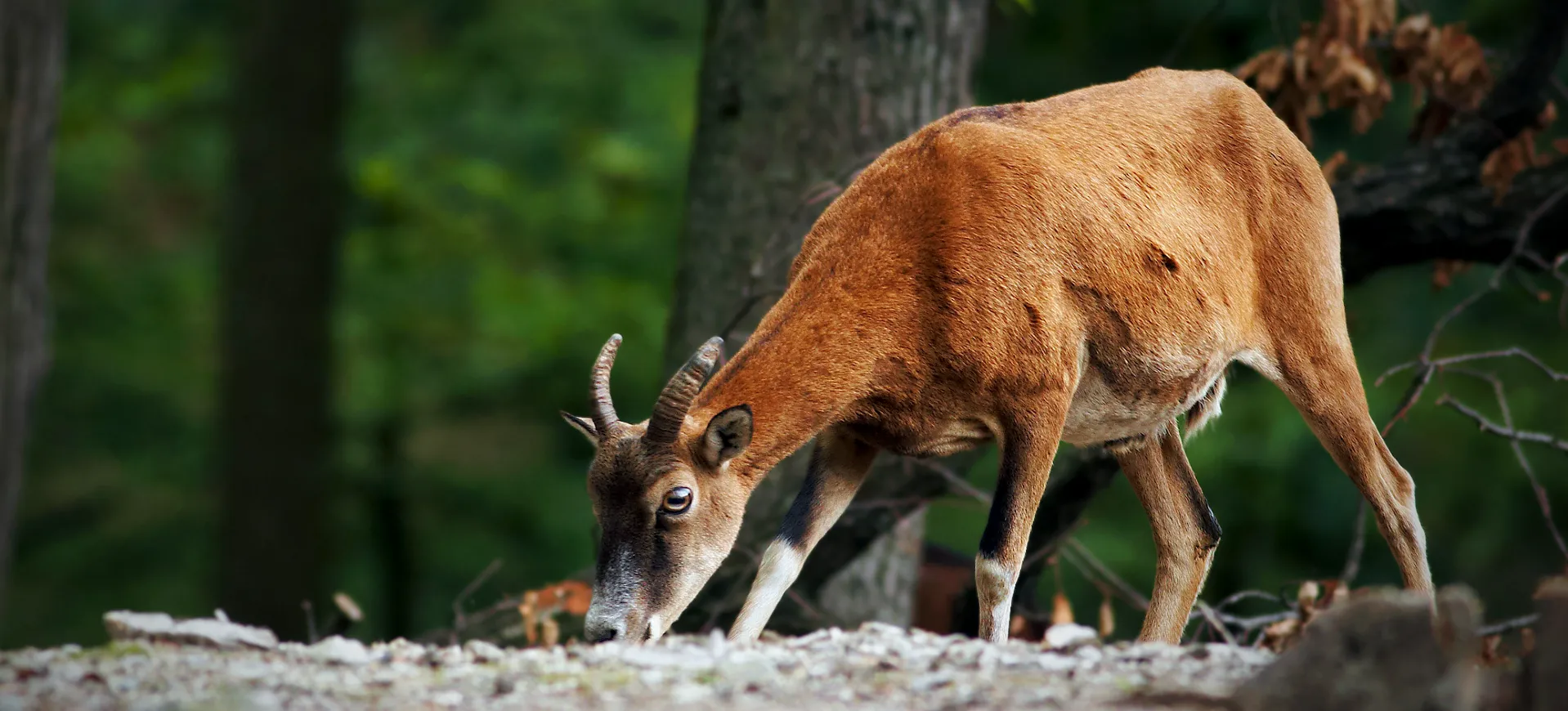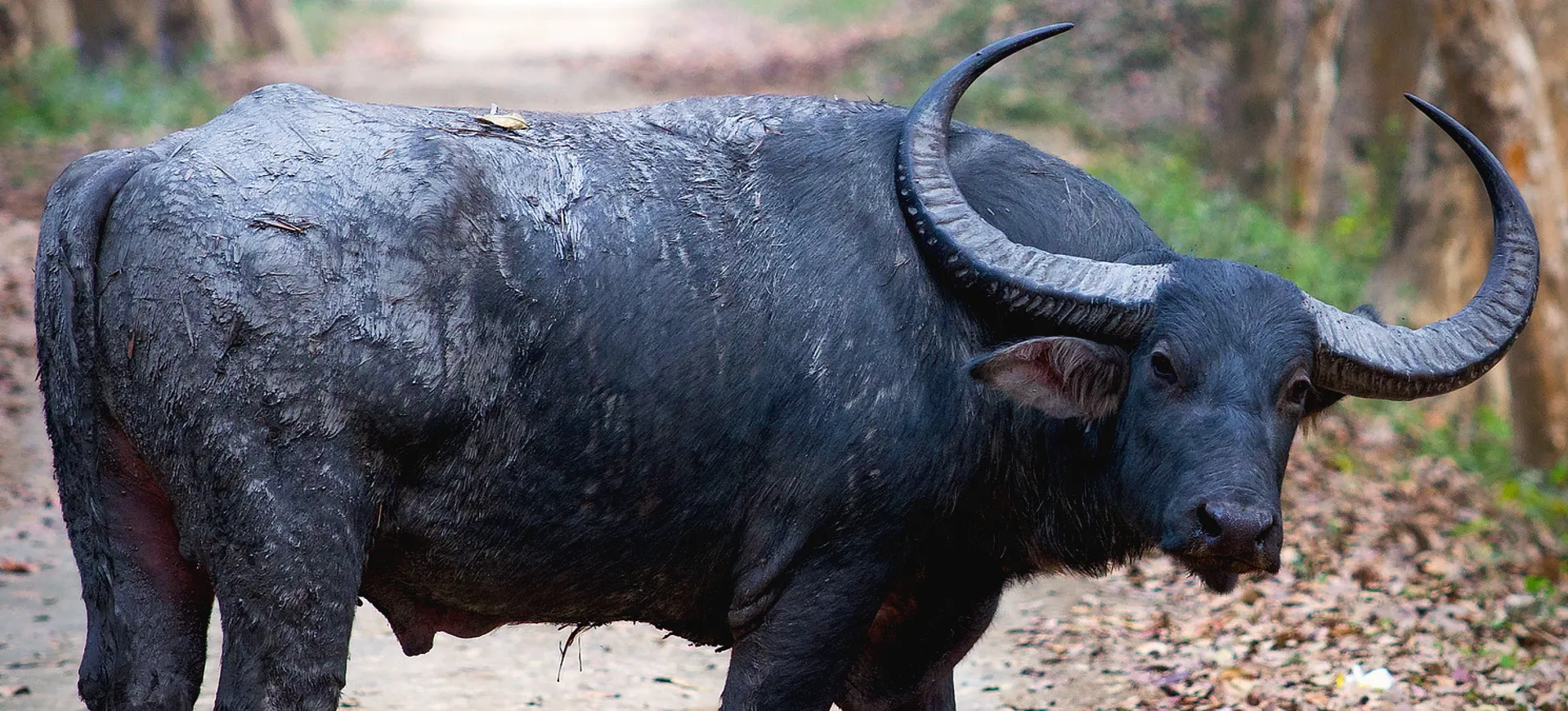Overview
The bongo (Tragelaphus eurycerus) is a large, forest-dwelling antelope native to Africa, known for its striking reddish-brown coat with white vertical stripes. This nocturnal and crepuscular species is highly elusive, relying on dense vegetation for cover and using its keen hearing and sense of smell to detect predators. Bongos are excellent runners and leapers despite their large size, and they navigate through thick forests with ease due to their low-slung body structure. They are social animals, typically found in small groups, though males tend to be more solitary outside of the breeding season.
There are two subspecies of bongos: the lowland or western bongo (Tragelaphus eurycerus eurycerus), found in West and Central Africa, and the eastern or mountain bongo (Tragelaphus eurycerus isaaci), which is native to the highland forests of Kenya. The mountain bongo is critically endangered, with fewer than 100 individuals remaining in the wild, while the lowland bongo is near threatened due to habitat loss and poaching. Both subspecies depend on dense forests for survival and play a crucial role in seed dispersal and maintaining forest health. Conservation efforts include breeding programs and habitat protection to prevent further population decline.
Bongos are one of the heaviest and most colorful species of African antelope, with both males and females sporting spiraled horns that can grow up to 40 inches (102 cm) long. Their distinctive white facial and body markings help with camouflage in dappled forest light. Unlike other antelopes, bongos have a unique habit of rubbing their horns against trees to remove the outer layer, revealing a lighter color underneath. Due to their shy nature, they are rarely seen in the wild, making them a species of high conservation concern.
Taxonomy
Kingdom
Phylum
Class
Order
Family
Genus
Species
Type
Current distribution:
The lowland bongo is distributed across fragmented populations in West and Central Africa, particularly in Cameroon, Gabon, the Republic of the Congo, and the Democratic Republic of the Congo. However, habitat destruction and poaching have significantly reduced its range, leaving populations increasingly isolated. The mountain bongo, endemic to Kenya, has suffered even greater declines, with wild populations restricted to small forested areas in the Aberdare Mountains and Mount Kenya. Conservation breeding programs aim to reintroduce individuals into these protected areas to bolster their numbers.
Deforestation for agriculture, illegal logging, and poaching threaten the bongo's distribution. Some populations persist in national parks and protected reserves, but enforcement remains challenging. Bongos avoid open areas and human settlements, making habitat fragmentation a major obstacle to survival. Without targeted conservation actions, their range is expected to shrink further in the coming decades.
Physical Description:
The bongo is a strikingly large antelope with a deep chestnut-red coat marked by 10 to 15 vertical white stripes that help it blend into dense forests. Its coat darkens with age, especially in males, and features a black dorsal stripe running along the spine. Both males and females possess long, spiraled horns that grow in a distinctive lyre shape, with male horns being thicker and longer. Large ears enhance their hearing, helping them detect predators such as leopards and hyenas in their dense forest habitat.
Bongos have a robust, muscular build with relatively short legs that enable them to move swiftly through thick undergrowth. Their large hooves stabilize muddy or uneven forest terrain, preventing them from sinking into soft ground. The body is slightly lower in the front and higher in the back, an adaptation that allows them to navigate sloped environments efficiently. They also have a distinctive white chevron marking between their eyes and white patches on their cheeks, adding to their unique facial features.

Lifespan: Wild: ~20 Years || Captivity: ~25 Years

Weight: Male: 485–892 lbs (220–405 kg) || Female: 331–518 lbs (150–235 kg)

Length: Male: 79–103 in (200–260 cm) || Female: 67–91 in (170–230 cm)

Height: Male: 47–55 in (120–140 cm) || Female: 43–51 in (110–130 cm)

Top Speed: 37 mph (60 km/h)
Characteristic:
Native Habitat:
Bongos inhabit dense tropical and subtropical forests, preferring areas with thick undergrowth and access to water sources. Depending on the subspecies, they are found in both lowland and montane forests, with mountain bongos occupying higher altitudes in Kenya’s Aberdare and Mount Kenya forests. These forests provide the necessary cover for their nocturnal and crepuscular lifestyle, allowing them to remain hidden from predators. The species thrives in humid environments with abundant vegetation and seasonal food availability.
Their reliance on undisturbed forests makes them highly susceptible to habitat destruction caused by deforestation and human expansion. Lowland bongos are found in fragmented West and Central Africa populations, including Cameroon, Gabon, and the Democratic Republic of the Congo. Mountain bongos, in contrast, are restricted to small protected areas, with their wild numbers declining due to poaching and habitat degradation. Conservation initiatives focus on maintaining protected reserves and promoting sustainable land use to support bongo populations.
Climate Zones:
Biomes:
Biogeographical Realms:
Continents:
Countries:
Diet:
Diet & Feeding Habits:
Bongos are herbivorous browsers that feed on leaves, bark, roots, fruits, and grasses found in their forested habitats. They use their prehensile tongues to strip leaves from branches and their strong molars to grind fibrous plant material. Fruits and fungi also form an essential part of their diet, providing additional nutrients. Their feeding behavior is vital in shaping forest composition by dispersing seeds and influencing vegetation growth.
These antelopes are most active during twilight hours, foraging for food in small groups or alone. During the dry season, they rely more on tree bark and roots when fresh leaves and fruits are scarce. Bongos also consume salt and mineral-rich soil, which helps supplement their diet and maintain their health. In captivity, they are fed a balanced diet of hay, fresh vegetables, fruits, and specially formulated pellets.
Mating Behavior:
Mating Description:
Bongos follow a polygynous mating system, where dominant males compete to access receptive females. Mating typically occurs during the wet season when food is abundant, ensuring calves are born under favorable conditions. After a gestation period of about 9.5 months, a single calf is born and remains hidden in dense vegetation for several weeks before joining the mother. The mother provides all parental care, nursing the calf until it is strong enough to keep up with the herd.
Calves grow rapidly and begin nibbling on vegetation within a few weeks, although they continue nursing for up to six months. Males leave their maternal groups upon maturity, while females often remain within their natal herds. Sexual maturity is reached at approximately two to three years of age. In captivity, breeding programs focus on maintaining genetic diversity to support conservation efforts.
Reproduction Season:
Birth Type:
Pregnancy Duration:
Female Name:
Male Name:
Baby Name:
Social Structure Description:
Bongos are generally shy and elusive, primarily adopting a semi-solitary or small-group lifestyle in dense forests. Adult males are typically solitary, only joining groups during the breeding season, while females and juveniles form loose herds of up to 10 individuals. These groups provide protection and social interaction, with dominant females leading movements and younger individuals following closely. Group communication involves vocalizations, scent marking, and body language, helping individuals coordinate movements and avoid predators.
Despite their quiet nature, bongos maintain social bonds through mutual grooming and occasional playful behavior, especially among juveniles. Males establish dominance through sparring contests using their large, spiraled horns but rarely engage in serious fights. During mating season, males may follow and interact with multiple females, displaying behaviors such as circling and head-lowering to indicate readiness. Adult males and females avoid each other outside breeding, preferring to move independently through their forested habitats.
Groups:
Conservation Status:
Population Trend:
The bongo has experienced significant population declines due to habitat loss, hunting, and disease. The wild population of the eastern or mountain bongo is estimated to be fewer than 100 individuals, making it one of the rarest antelopes in the world. The lowland bongo (Tragelaphus eurycerus eurycerus) is more numerous but still faces habitat fragmentation and poaching threats. While captive breeding programs have helped maintain genetic diversity, reintroductions into the wild have been challenging due to ongoing environmental pressures.
Conservation efforts, including habitat protection and anti-poaching initiatives, aim to stabilize and restore wild populations. Bongos are particularly vulnerable to hunting for bushmeat and traditional medicine, and their striking appearance makes them a target for the illegal wildlife trade. Habitat destruction caused by logging and agricultural expansion further restricts their range, reducing available food sources and increasing human- wildlife conflict. Without immediate conservation action, especially for the critically endangered mountain bongo, wild populations will continue to decline, placing the species at risk of extinction.
Population Threats:
The bongo faces severe threats from habitat destruction due to deforestation, agricultural expansion, and human settlement. Logging and illegal timber harvesting have significantly reduced the dense forest cover that Bongos depend on for shelter and food. As forests are cleared, bongos are forced into smaller, fragmented habitats, increasing their vulnerability to predators and reducing their access to diverse food sources. Habitat fragmentation also isolates populations, reducing genetic diversity and lowering reproductive success.
Poaching is another major threat, as bongos are hunted for their meat, skins, and horns, despite legal protections in some areas. The eastern or mountain bongo (Tragelaphus eurycerus isaaci) is particularly at risk due to its already low population numbers, devastating any hunting pressure. Additionally, disease transmission from livestock poses a serious risk, as bongos share habitats with domestic animals that may carry infectious diseases. Climate change further exacerbates these threats by altering vegetation patterns and increasing the frequency of extreme weather events, making survival even more challenging.
Conservation Efforts:
Efforts to conserve the bongo focus on habitat protection, anti-poaching initiatives, and captive breeding programs. Protected areas such as Kenya’s Aberdare National Park and Mau Forest Complex have been established to safeguard the critically endangered mountain bongo population. Organizations like the Mount Kenya Wildlife Conservancy and the Bongo Surveillance Project monitor wild populations and work to restore degraded habitats. International breeding programs in zoos maintain genetically viable individuals, with some efforts aimed at reintroducing captive-bred bongos into the wild.
Through education and sustainable land-use programs, conservationists collaborate with local communities to reduce habitat destruction and human- wildlife conflicts. Anti-poaching patrols and law enforcement efforts are being strengthened to combat illegal hunting, which remains a significant threat. Research on disease prevention is also crucial, as bongos are vulnerable to livestock-borne illnesses that can devastate populations. Long-term survival depends on continued habitat restoration, stronger legal protections, and increased global awareness of the species’ critically endangered status.
Additional Resources:
Fun Facts
- The bongo is the largest and heaviest forest-dwelling antelope, with males weighing up to 900 lbs (408 kg).
- Both male and female bongos have long, spiraled horns, which is unusual among antelopes since females of most species lack them.
- Bongos have a striking reddish-brown coat with white vertical stripes that help them blend into dense forests.
- Despite their large size, bongos are incredibly agile and can move swiftly through thick vegetation.
- They are mostly nocturnal or crepuscular, meaning they are most active at dawn and dusk.
- Bongos are known for their “hiding” behavior—when startled, they freeze or dash into dense cover to avoid predators.
- They use their long tongues to grasp and pull leaves like giraffes.
- Unlike many antelopes, bongos do not rely heavily on open grasslands and prefer the cover of forests.
- Males produce deep, resonant grunts to communicate, while females and young use soft bleats and snorts.
- The mountain bongo (Tragelaphus eurycerus isaaci) is critically endangered, with fewer than 100 individuals left in the wild.

















































































